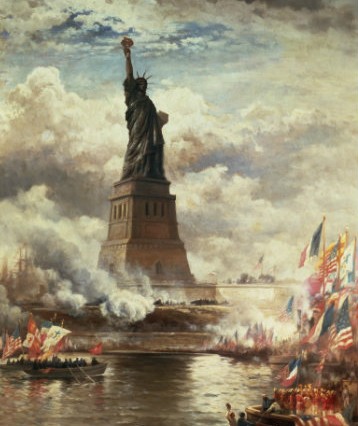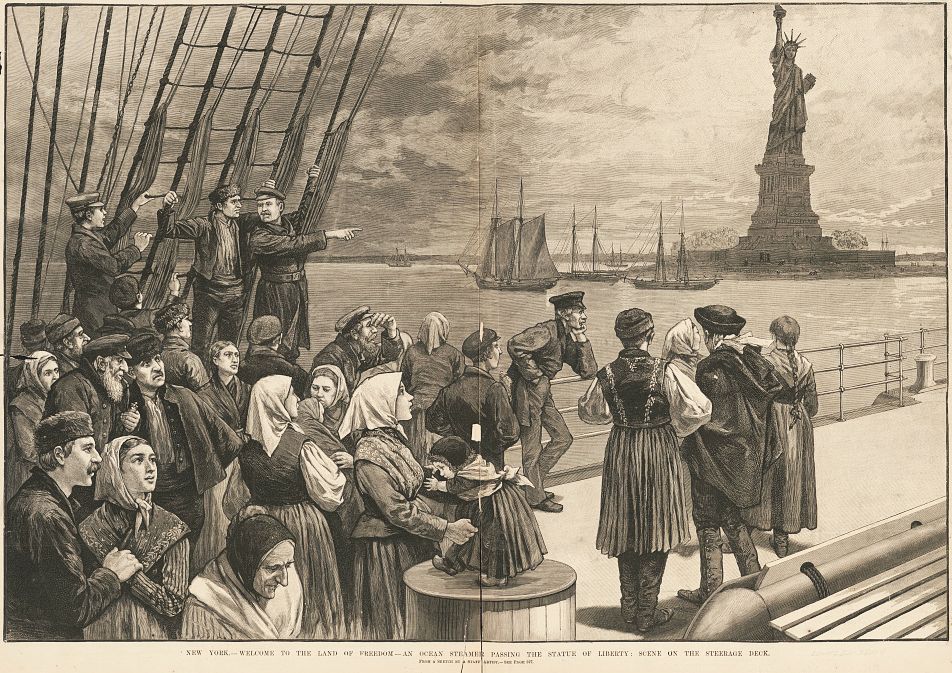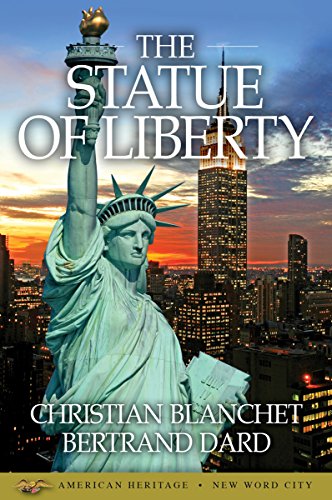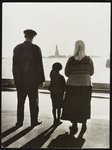The Statue of Liberty has been glorified, romanticized, trivialized, and over-publicized. But the idea of “Liberty Enlightening the World” endures.
-
Summer 2017
Volume62Issue1

Its size alone no doubt would have been enough to guarantee the Statue of Liberty affection right from the start in 1886, the year it was completed. Bigger was surely better in the eyes of most American beholders in that expansive era. When young Theodore Roosevelt of New York, a candidate for mayor the same year, affirmed that big things were in the spirit of the times and a fact of American life, he was addressing a small-town Fourth-of-July crowd in the Dakota Territory, but he could have been speaking for almost anyone, anywhere in the country. “Like all Americans, I like big things,” he said, “big prairies, big forests and mountains, big wheat fields, railroads, herds of cattle, too-big factories, steamboats, and everything else.”
Frédéric Auguste Bartholdi, the resolute genius of the great work, observed in a letter home, “Everything is big here - even the peas. . . .” As a Frenchman, he preferred his peas small. He also had some difficulty liking Americans, who, by his lights, were deficient in taste and charm. Still, for a land of such expanse, he could envision only a statue of “colossal proportions,” of “extraordinary proportions.”
At the time of completion, the statue was not just the largest ever built but the tallest structure of its kind in the world. And the vital statistics still seem fabulous. From its toe to the tip of its upheld torch, the statue is 151 feet tall. Counting the pedestal, it rises 305 feet above the tide. Its head measures 10 feet from ear to ear, its nose a good 4 feet in length. It weighs 450,000 pounds, or 225 tons, its sheathing of hammered copper accounting for nearly half of that. Inside, the route from the top of the pedestal to eye level is a steep climb of 154 steps, the same as a twelve-story building. The fact that it stands where it does, taking the winds of New York Harbor full force in all seasons, is testimony to an internal design far more ingenious and important as a feat of structural engineering than most people are aware.
Yet all that hardly explains how we feel about it, our Miss Liberty or “Liberty Enlightening the World,” as once it was known. For all the statistics, the publicity, for all we think we know about the statue, it remains an extremely elusive subject with many sides and a fascinating history.
Of utmost importance is the statue’s placement, at the gateway to America. It is emphatically a New York landmark. If it had been put up in Washington, D.C., or St. Louis or anywhere other than New York, we would not feel about it as we do; that is certain. There is simply no better or more appropriate place, which the visionary Bartholdi saw at once the day he sailed through the Narrows on his initial scouting trip. Indeed, as he later said, his plans for the statue became clear only when he first saw the “thrilling” harbor filled with ships “like a crowd upon a public place.”
It was an age that understood the power and value of public places and cared seriously about public monuments and public institutions. New York, largest and wealthiest of our cities, was building them as never before. The fifteen years between Bartholdi’s first visit, in 1871, and the unveiling of the statue saw the rise or completion of the Metropolitan Museum of Art, the American Museum of Natural History, Central Park, and the Brooklyn Bridge. Architects and builders and campaigners for funds talked of the civic pride such works engendered and how they would “stand down the ages” like the monuments of ancient Egypt. Bartholdi had actually been to Egypt and gazed at “all those marvelous ruins.”
In Washington, at the center of Pierre Charles L’Enfant’s mall before the Capitol, the Washington Monument was at last completed (in 1884), the loftiest, solid-masonry tower ever built. With the colossus in New York Harbor, the nation had two monuments comparable to those of ancient times.
For Bartholdi, for the workers in the shops of Gaget and Gauthier in Paris who first built, then dismantled and packed the statue for shipment, for Gustave Eiffel, the versatile French engineer who devised its iron skeleton, and for the many thousands of French citizens of all walks who contributed the money to pay for this greatest-ever-gift to the United States, it was both a way of showing French regard for our noble founding principles and helping the French recover their self-esteem after the debacle of the Franco-Prussian War. Vaunted France, the France of Victor Hugo and Louis Pasteur and Ferdinand de Lesseps, the France of Emperor Napoleon III, and what, by reputation, was the most formidable army in Europe, had been crushed by the Germans like an overripe melon. The response of the French people afterward, however, was stunning. They would show that France was France again in “dazzling form,” not on the field of battle but in the arts and sciences and with monumental works of peace and progress. Bartholdi himself felt the humiliation of the late war to the depths of his being. He had served in it; he had seen his native Alsace ceded to Bismarck’s new Germany.

But it is not simply that the statue, the product of that impulse and that age, stands on or beside the harbor. She is in it, she is of it - on little Bedloe’s Island, the site of an old fort and, at odd times, a pest-house and a gallows. She is surrounded by salt water, by an arm of the Atlantic, which has much to do with how we feel about her. She is, thus, ever in the midst of passage for all who come and go - alone, unrivaled, her beacon torch visible for miles.
She is like the light left on at home when you go out at night. For all of us who were born here and who have gone away and returned from our travels and from two wars, she has meant just that – “Home, I’m home. This is my place. I didn’t take the wrong boat.” Coming and going by plane, as we do now, we still pick her out below. “There’s the Statue of Liberty! Down there!” you hear people saying with excitement.
For those of us who came from abroad in such overwhelming numbers, year upon year, when Ellis Island was the point of debarkation, she meant welcome to a new home. She marked the threshold. “From her beacon-hand/ Glows worldwide welcome,” wrote Emma Lazarus in her poem.
In no country other than our own has so much American history transpired as in France and in the twentieth century especially, with its terrible world wars. There are 60,000 American soldiers buried in France, at places with names that are as much a part of our history as are Yorktown or Antietam. For the living who came home, Bartholdi’s statue had a meaning he never anticipated and that most of us now can only imagine.

But what of those others in such different times? Can we ever know what they felt?
“I’ve never seen anything that looked so good as the Liberty Lady in New York Harbor,” wrote thirty-four-year-old Captain Harry Truman to his sweetheart Bess Wallace in 1919, on returning from the First World War and the Argonne-Meuse campaign that took more American lives than any other engagement in either war. “You know the men have seen so much and been in so many hard places that it takes something real to give them a thrill, but when the band on that boat played ‘Home Sweet Home,’ there were not very many dry eyes.”
We have seen the newsreels from 1919 and 1945 and those expectant faces massed aboard the incoming troopships. We have seen the photographs of immigrants jamming ships’ rails for a first look. One of them, Helen Mamikonian, a professor in Boston who arrived from France in the 1950s recalled: “I was a teenager, and I was alone on the boat. It was kind of frightening, you know, to cross the Atlantic by yourself. I met a very nice Italian girl about my age and another Italian, a young boy, and the three of us got up; it was early, five-thirty, six o’clock. We got up and ran to the deck . . . . She was silhouetted very clear, because we were very close to her as the tugboats came to pull us; we passed her very slowly. Of course we had to look up. She was beautiful . . . . Imposing, a good word, she looked imposing.”

Others of us came to the experience from our own hinterland. Paul Horgan, the distinguished author and historian, remembered as a small boy traveling down from upstate New York with his father, who took him to see the statue because “he was trying to make an American of me.” How much is contained in that deceptively simple recollection. And the process continues, with no limit on one’s age or sophistication or relative familiarity with U.S. institutions, “I become an American all over again when I see the statue,” remarked Daniel J. Boorstin, the former Librarian of Congress, who grew up in Oklahoma.
The statue has been glorified, romanticized, trivialized, and over-publicized for purposes that often have little or nothing to do with its intended meaning. Like its near neighbor and contemporary, the Brooklyn Bridge, it has been stitched on pillows, embossed on silver spoons, printed on dinner plates, bandanas, T-shirts, and cocktail napkins. You can buy it in the form of a rubber stamp. And in ersatz bronze, with or without thermometer, it remains the all-time perfect cheap souvenir of New York - the Empire State Building its only rival.
Its image has been enlisted to sell war bonds, biscuits, horsehair brushes, life insurance, credit cards, mineral oil, champagne, cheese, cigarettes, and sewing machines. It has been cartooned and lampooned without end. Today, it is praised and celebrated and photographed as it has not since the damp day in October 1886 when Bartholdi, a marvel in full dress, climbed to its crown to cut loose its veil with his own hand.
Like all great events in history, it needs to be seen in the context of its times, of politics and technology and such largely forgotten and fascinating influences as those of the Freemasons. Like all great achievements in history, it is to a large extent the way it is because a particular group of people were the way they were. It is, among other things, a monument to several glory-struck, gloriously outsized egos of a kind only the nineteenth century could produce, sculptor Bartholdi being the prime example. He is the sort of character Jules Verne might have invented. Imagine discussing with a few friends, over dinner one evening at a country home near Paris, that you want to commemorate America’s democracy in some way, a fairly vague discussion that will one day result in the creation of the greatest statue on earth, a structure taller than any ever attempted before, in a distant land where you have never set foot and know no one, and then pursuing that vision with boundless persistence and enthusiasm for the next twenty years.
Besides Bartholdi is Edouard de Laboulaye, French professor of law and author of a three-volume history of the United States, who was host that evening near Paris and a participant in the discussion of plans to create a monument celebrating liberty; and Eiffel, who ranks with such giants of heroic nineteenth-century engineering as Brunei and the Roeblings and whose subsequent triumph, the Eiffel Tower, would become for Paris what the Washington Monument is for our capital.

The Americans include President Grover Cleveland; the brilliant Richard Morris Hunt, the first American trained at the Ecole des Beaux-Arts, architect to the Vanderbilts and Astors and designer of the statue’s pedestal; and Joseph Pulitzer, a Hungarian immigrant, the strange, ambitious publisher of the New York World who with the power of his paper raised $ 100,000 to pay for the pedestal.
“Colossal statuary does not consist simply in making an enormous statue,” Bartholdi insisted. “It ought to produce an emotion in the breast of the spectator, not because of its volume but because its size is in keeping with the idea it interprets. . . .”
The aged Victor Hugo, after seeing the statue in Paris, is said to have written to Bartholdi: “Form . . . is nothing without the spirit; with the idea it is everything.”
The statue is still there, unrivaled at the gateway. She isn’t a warrior. She isn’t bombastic or threatening. She isn’t a symbol of power. The Statue of Liberty is an act of faith.

